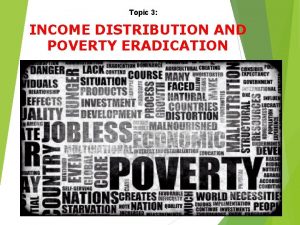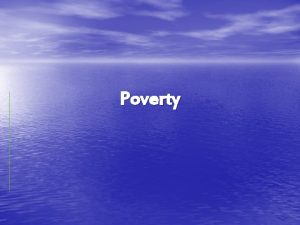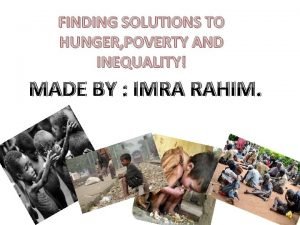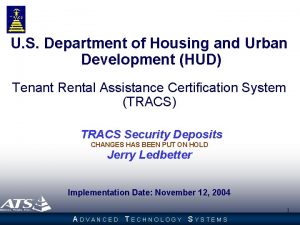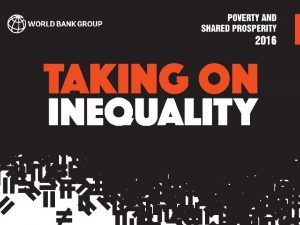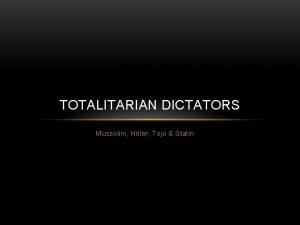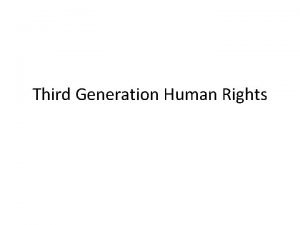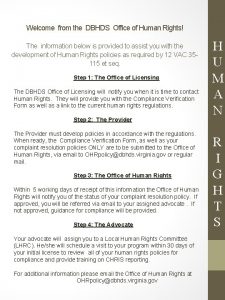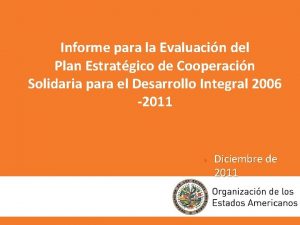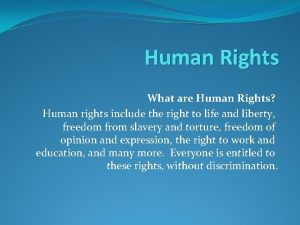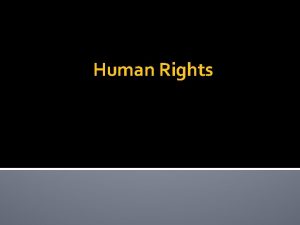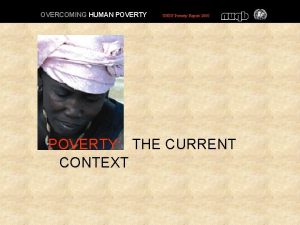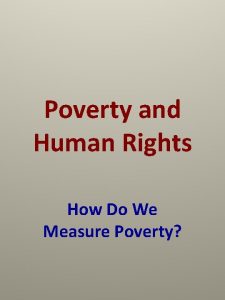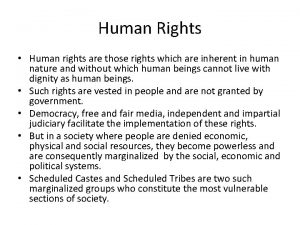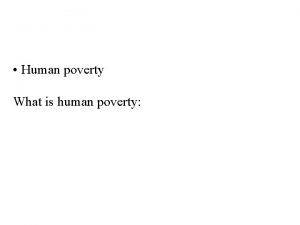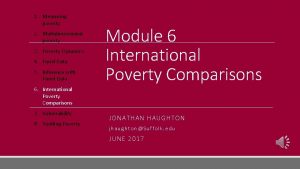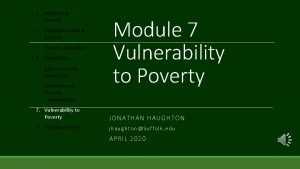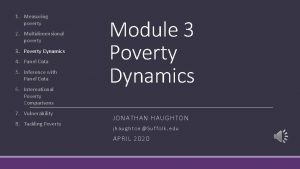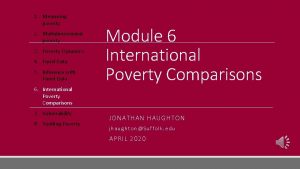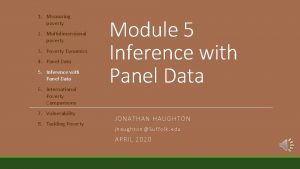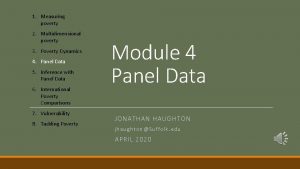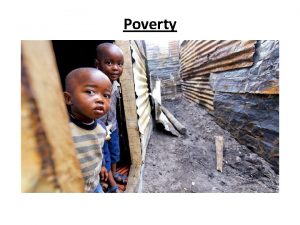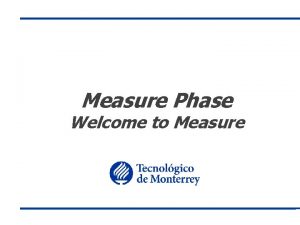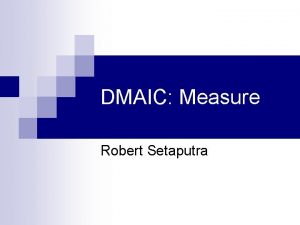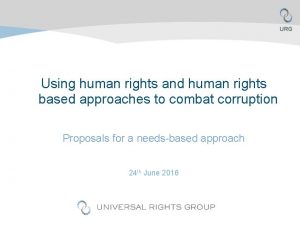Poverty and Human Rights How Do We Measure






































- Slides: 38

Poverty and Human Rights How Do We Measure Poverty?

Is Globalization Good for the World’s Poor? According to the standard measure of poverty the answer is “yes. ” But that tells you more about the standard measure than it does about the condition of the poor.

Poverty and Human Rights How Many Are Poor in the World Today? The Standard Measure of Poverty by the World Bank and others is in Terms of Percentages Relative to the Population. By this Measure Poverty is Declining. But is Head Count Really an Adequate Measure of Poverty?

Measuring Poverty Statistics are not nearly so obvious as we are inclined to think. Establishing the percentage of poor people within a population is not nearly so simple or so straightforward as taking the temperature of water in a bathtub. .

Taking Poverty’s Measure If you take a snapshot view, for example, and ask how many people are poor at any particular moment in time, you will necessarily under-estimate the number of poor relative to another measure that gives equal weight to every human life.

Taking Poverty’s Measure Poor people live much less long than those with more than enough for themselves. So if you take a snapshot view, you necessarily over-represent the lives of those whose lives are long and underrepresent the lives of those whose lives are short.

Taking Poverty’s Measure So if you really want to weight each person in the world equally, you should not take a snap-shot view.

Taking Poverty’s Measure If you adopt a different way of looking at the lives of people and ask, for example, how many are chronically undernourished, you come to the opposite conclusion: the number of world’s poor has sharply increased since 1996

Taking Poverty’s Measure Chronically Undernourished Persons in Millions per Year 1996 -2004 878 853 843 788 833 848 963 1025 925 — from the F. A. O at the UN.

Taking Poverty’s Measure If you look at the latest DMG (“Development Millennium Goals”) Report, you see that the UN has also noticed that, while their figures show poverty going down, the number of chronically undernourished is going up. What accounts for the discrepancy?

Taking Poverty’s Measure The UN offers the following explanation that someone like Thomas Pogge finds to be a wonderful example of doublespeak: “This disconnect between poverty reduction and the persistence of hunger has brought renewed tension to the mechanisms governing access to food in the developing world. ”

Taking Poverty’s Measure But the DMG Report gives no explanation for the disconnect. What is the explanation? Why are the poverty and hunger numbers diverging?

Taking Poverty’s Measure In order to understand the discrepancy we have to understand how the poverty numbers are constructed. How the hunger numbers are constructed is fairly obvious. What about the poverty numbers?

Taking Poverty’s Measure The World Bank is the monopoly provider of the global numbers. The Bank does it by establishing what is called “the poverty line” and they define it in terms of purchasing power in U. S. dollars

Taking Poverty’s Measure Imagine Purchasing Power as a Box If you can’t fill it, you’re “poor. ”. What Goes Into the Box?

How Big is the Box? The World Bank uses a “box” based on “[cost of acquiring basic needs] … that would enable individuals and families to assume basic responsibilities and to enjoy fundamental rights. ” .

Measuring Poverty By the Bank’s measure, you’re poor if you have less than the equivalent of $1. 25 in your box, in purchasing power in U. S dollars person per day.

Taking Poverty’s Measure This figure is then converted into other currencies in the poorer countries taking into account the higher purchasing power of those currencies in those countries.

Taking Poverty’s Measure When you first hear this figure and you live in the United States , this number, $1. 25 person per day, seems to be an extremely small amount and you may well wonder “how is anyone going to survive on that ridiculously small figure? ”

Taking Poverty’s Measure But then you may think: “Well maybe in a country like India $1. 25 goes a long way. ” But to think this would be a mistake because the world bank is not using market exchange rate but purchasing power parity as its measure. The Bank starts with the purchasing power of 1. 25 U. S. dollars in 2005.

Taking Poverty’s Measure The Bank then converts this amount into the currencies of countries in the developing world and then adds in the local Consumer Price Index figures to see what the purchasing power would be moving away from what $1, 25 could buy you in 2005, taking into account all the prices that prevail in the U. S. and the other country at the time to maintain purchasing power parity.

Taking Poverty’s Measure So once you convert your $1. 25 into all the currencies of the world in 2005 and then use the local Consumer Price Index to move forward and backward in time, you can compare the income of any household at any time anywhere in the world with any other household

Taking Poverty’s Measure So What are the Problems With the Way Poverty is Measured by the World Bank?

Taking Poverty’s Measure Six Problems • Excessive Sensitivity of the Poverty Trend According to How High or Low You Set the Poverty Line. • Inconsistency • The Distortion That Arises from Purchasing Power Parity when Applied to Tradable and Moveable Goods (land v. food) • A Measure like the Bank’s which is Binary (where there are Poor and Non-Poor) has a Distortive Effect on Social Policy

Taking Poverty’s Measure Six Problems cont. . . • Failure to Take Account of Intra. Household Distribution and Gender Disparities. Food and Education May Go to the Boys First. • Failure to Take Into Account Other Dimensions of Poverty: Climate, Leisure Time, the Role Played by Public Goods

Measuring Poverty What is a “basic necessity? ” How much do you need to sustain a human life? How do you put a price tag on it?

Purchasing Power What are you expected to sell to get what it takes to raise $1. 25 a day, so you won’t be counted among the world’s “poor? ” • The Goat You Use for Milk? • A Room in Your House? • Your child?

Consider Thomas Pogge’s Use of the numbers: “The average person in extreme poverty can buy about as much each year as can be bought with $405 in a typical rich country. ”

By Pogge’s Measure: • 13 percent (830 million) of all human beings are undernourished; • 17 percent (1, 100 million) lack access to safe water; • 41 percent (2, 600 million) lack access to basic sanitation; • 16 percent (1, 000 million) lack adequate shelter; • 31 percent (2, 0000 million) lack access to essential drugs • 25 percent (1, 600 million) lack electricity

Taking Poverty’s Measure “One third of all human deaths are due to poverty-related causes. . . such as starvation, diarrhea, pneumonia, tuberculosis, malaria, measles, and preventable, public health-related, perinatal deprivations, like lack of food, essential medicine, and safe drinking water. ”

Taking Poverty’s Measure If an industrialized country such as the U. S. had its proportional share of these deaths, severe poverty would kill 16, 000 persons in the United States every week.

The Measure of Poverty 300 million people have died “ordinary deaths” from poverty related causes since the end of the Cold War.

Poverty’s Measure By “ordinary deaths” Pogge Means Deaths Not Caused by Heart Disease and other Common Killers.

300 Million “Ordinary” Deaths In comparison to 11 Million who died in the German holocaust 30 Million who starved to death in Mao’s Great Leap Forward 2 Million who were killed at the hands of the Khmer Rouge and the 850, 000 who were slaughtered in Rwanda.

By Pogge’s Measure of Poverty If the names of the poor were listed on a Vietnam-War-Memorial-like Wall, they would cover a wall from Detroit to New York: 480 miles long

Should Poverty be a Human Rights Violation? Practically? Morally? Legally?

Hear Thomas Pogge On Tuesday, October 8 th, 2013 THOMAS POGGE

TUESDAY OCTOBER 8, 2013 Come on October 8 th and Find Out: “What Do Human Rights Demand of Us? ” Thomas Pogge Zinner Forum 5: 10 – 7: 00 pm
 Distinguish between absolute poverty and relative poverty
Distinguish between absolute poverty and relative poverty Human poverty index calculation
Human poverty index calculation Negative rights vs positive rights
Negative rights vs positive rights Conclusion of rights
Conclusion of rights Legal rights vs moral rights
Legal rights vs moral rights Positive rights and negative rights
Positive rights and negative rights Hail
Hail Littoral vs riparian rights
Littoral vs riparian rights Negative rights vs positive rights
Negative rights vs positive rights Negative right
Negative right Negative right
Negative right Is measure for measure a comedy
Is measure for measure a comedy Life orientation grade 11 democracy and human rights
Life orientation grade 11 democracy and human rights The basic of human rights
The basic of human rights Relative and absolute poverty
Relative and absolute poverty Poverty and juvenile delinquency
Poverty and juvenile delinquency Esperanza’s house symbolizes poverty and
Esperanza’s house symbolizes poverty and St john chrysostom on wealth and poverty pdf
St john chrysostom on wealth and poverty pdf Poverty and hunger solutions
Poverty and hunger solutions Symbolic interactionist perspective on poverty
Symbolic interactionist perspective on poverty Hudco full form
Hudco full form Inequality and poverty
Inequality and poverty Greed and poverty
Greed and poverty What is rights in social studies
What is rights in social studies What evidence do you see of stalin being militaristic
What evidence do you see of stalin being militaristic First generation of human rights
First generation of human rights Human rights theory
Human rights theory Thematic essay human rights
Thematic essay human rights State human right commission rajasthan
State human right commission rajasthan Vienna declaration of human rights
Vienna declaration of human rights The meaning of human rights
The meaning of human rights Characteristics of rights
Characteristics of rights Projects abroad human rights office
Projects abroad human rights office European human rights moot court competition
European human rights moot court competition Alberta duty to accommodate
Alberta duty to accommodate Dbhds human rights
Dbhds human rights Traineeship european court of human rights
Traineeship european court of human rights Human rights day
Human rights day Human rights definition
Human rights definition
